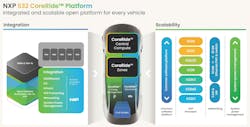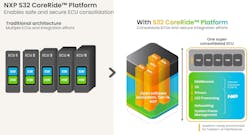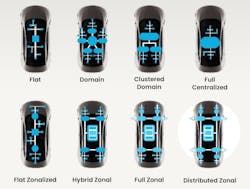Platform Integration Key to Building Software-Defined Vehicles
What you’ll learn:
- What NXP’s CoreRide Platform encompasses.
- Why integration is key to software-defined vehicles.
NXP’s S32 automotive processor family got more than just an upgrade with the S32N series that's at the top of the S32 CoreRide Platform (Fig. 1). Not many details are available about the chips themselves, other than they host the latest Arm Cortex processor cores.
They can handle a mix of real-time and lockstep solutions that take advantage of virtualization to make software-defined vehicle (SDV) development significantly easier. The S32 family offers chips like the S32G and S32K, which target different nodes within an SDV.
Numerous system-on-chips (SoCs) and applications will still be distributed around an SDV, but many of the engine/electronic control unit (ECU) functions are consolidated into a centralized SoC like the S32N (Fig. 2).
These applications and operating systems will be isolated using hypervisor and container technology. It will allow for safety and security subsystems to support standards such as ISO 26262 and attain ASIL-B and ASIL-D. The S32N features multiple cores that can be configured in various ways, including pairing them into lockstep operation.
Bringing applications into a central system has significant advantages. It enables resources to be shared and allocated as needed. Over-the-air updates can be simplified because resources are in a single location. Security is easier to manage, too, and it facillitates adding features. Debugging a single SoC is easier than discrete devices. Cabling can often be reduced and network management is partially virtualized.
The conventional approach to SDV development is to leave the integration of the operating system, middleware and other services to developers (Fig. 3). This is a non-trivial task in an SDV that will still have multiple ECUs. Developers will continue to have choices with the platform, though, such as different operating systems, but the integration has been done by NXP and its partners.
The S32 CoreRide Platform’s initial ecosystem includes Accenture, Archermind, Blackberry QNX, Elektrobit, ETAS, Green Hills Software, Sonatus, Synopsys, TTTech Auto, Valeo, Vector, and Wind River Systems. They cover everything from operating systems and hypervisors to middleware and automotive applications.
“Sonatus is fully committed to the CoreRide Platform, building on our proven history of delivering tight integration with NXP silicon solutions in mass production for automotive,” said Jeffrey Chou, co-founder and CEO, Sonatus.
He added, “The Sonatus Vehicle Platform, which accelerates the shift to software-defined vehicles, is performance-optimized for a range of NXP solutions to deliver scalability, flexibility, and speed time-to-market. We are proud to be in production with leading OEMs with the S32G vehicle processor and are actively integrating with the new S32N family to enable the future of automotive architectures.”
Dan Mender, VP Business Development at Green Hills Software, said, “Until NXP’s S32 CoreRide Platform, automotive OEMs and T1s were responsible for all the integration, test, and validation of the OSes, hypervisors, and middleware needed to support the essential foundational functions of the vehicle. But now, S32 CoreRide greatly reduces integration efforts while bringing new levels of system scalability.
"The collaboration between Green Hills and NXP provides a pre-integrated platform that decouples the underlying hardware + hypervisors + RTOS + middleware. It enables OEMs and Tier 1s to develop applications independently from the final vehicle architecture and even the specific S32 processor in the system.
"Another important Green Hills contribution to the CoreRide Platform is its OS-agnostic multicore debugger and system history viewer that “sees” across all of the heterogenous cores and operating systems in the system. This provides unprecedented visibility into the complex multicore/multi-OS system for quickly finding and fixing bugs and removing performance bottlenecks."
There's no single SDV architecture (Fig. 4), but CoreRide addresses them all. How this is done will be up to the system designer and developers. The S32N will help concentrate functions into control nodes.
SDVs obviously represent where the automotive market is headed and the variety of architectures all have a high level of complexity. Anything like the CoreRide Platform, which simplifies the design and development cycle, will quicken time-to-market as well as reduce development and support costs.
Links
About the Author
William G. Wong
Senior Content Director - Electronic Design and Microwaves & RF
I am Editor of Electronic Design focusing on embedded, software, and systems. As Senior Content Director, I also manage Microwaves & RF and I work with a great team of editors to provide engineers, programmers, developers and technical managers with interesting and useful articles and videos on a regular basis. Check out our free newsletters to see the latest content.
You can send press releases for new products for possible coverage on the website. I am also interested in receiving contributed articles for publishing on our website. Use our template and send to me along with a signed release form.
Check out my blog, AltEmbedded on Electronic Design, as well as his latest articles on this site that are listed below.
You can visit my social media via these links:
- AltEmbedded on Electronic Design
- Bill Wong on Facebook
- @AltEmbedded on Twitter
- Bill Wong on LinkedIn
I earned a Bachelor of Electrical Engineering at the Georgia Institute of Technology and a Masters in Computer Science from Rutgers University. I still do a bit of programming using everything from C and C++ to Rust and Ada/SPARK. I do a bit of PHP programming for Drupal websites. I have posted a few Drupal modules.
I still get a hand on software and electronic hardware. Some of this can be found on our Kit Close-Up video series. You can also see me on many of our TechXchange Talk videos. I am interested in a range of projects from robotics to artificial intelligence.





